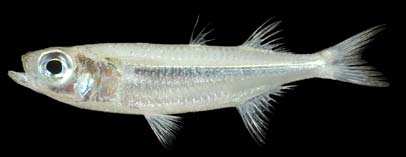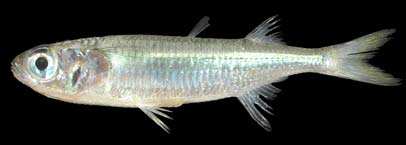ATHERINIDAE
Silversides
By Seishi Kimura
 Atherinomorus duodecimalis |
 Atherinomorus pinguis |
 Atherion elymus |
 Hypoatherina valenciennei |
|
Small to medium sized marine and freshwater fishes; maximum size about 70 cm, commonly 5-10 cm. Body slender cylindrical or somewhat compressed with round belly. Mouth small and terminal; hind tip of upper jaw not extending to posterior margin of eye. Two dorsal fins well separated, the first with III to VIII flexible spines separated each other at base; the second dorsal and anal fins with a single spine followed by soft rays (D2 I, 7-13; A I, 8-21); caudal fin forked; pectoral fins high on the sides of body with 10-19 rays; pelvic fins abdominal to subabdominal with I, 5. Scales cycloid, relatively large; lateral line absent. Color: body greenish or greenish brown dorsally, silvery ventrally; a broad silvery (black in preserved specimens) stripe on the side of body. Similar families occurring in the area. Atherinidae is distinguished from the following similar families in having round belly, anus located behind pelvic fin base, 2 dorsal fins, first dorsal fin spines separated each other at base, and a single anal fin spine. Engraulidae: hind tip of upper jaw extending beyond posterior margin of eye; a single dorsal fin; no spines in fins. Isonidae: body compressed with keeled belly. Mugilidae: first dorsal fin with IV spines, anterior 3 spines close together at base; II or III anal fin spines. Phallostethidae: anus anterior, located under head. Remarks. Occurring in tropical to temperate marine, estuarine, and freshwater areas; usually found in beaches and seagrass areas. Eggs with entangling filaments on chorion. |

|
|